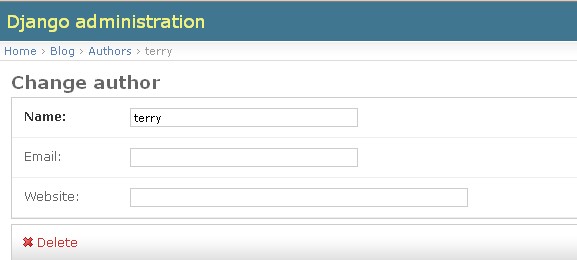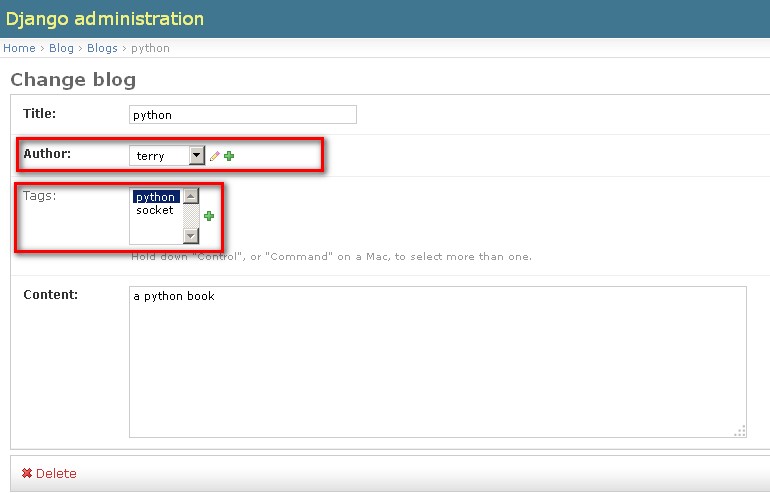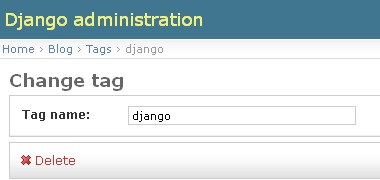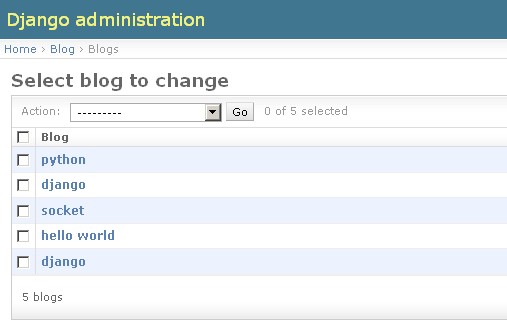django提供了非常方便的数据模型,可以非常简易的设计时间结构,URL结构,输入框等等,django都已经有编写好的数据结构,对于我这种初级编程来说再好没有,否则我就要自己写数据约束,格式,出错等
对于一个博客系统最基本包含三个要素,“作者”, “博客”,“标签”
#/myblog/myblog/blog/models.py
1 from django.db import models
2
3 # Create your models here.
4
5 class Author(models.Model): #作者信息
6 """docstring for Author"""
7 name = models.CharField(max_length=30)
8 email = models.EmailField(blank=True)
9 website = models.URLField(blank=True)
10
11 def __unicode__(self): #方便查询时返回一个名字,否则是一个实例
12 return self.name
13
14 class Tag(models.Model): #标签
15 """tag of book"""
16 tag_name = models.CharField(max_length = 30)
17 create_time = models.DateTimeField(auto_now_add =True )
18
19 def __unicode__(self):
20 return self.tag_name
21
22 class blog(models.Model): #博客
23 title = models.CharField(max_length=50) #标题
24 author = models.ForeignKey(Author) #作者 作者与博客是一对多的关系,一个博客只有一个作者,一个作者可以有多个博客
25 tags = models.ManyToManyField(Tag, blank=True) #标签 标签与博客是多对多的关系,一个博客有多个标签,一个标签也可以有多个博客,因此初始化时不能直接赋值,它是一个列表
26 content = models.TextField() #内容
27 date_time = models.DateTimeField(auto_now_add = True)
28
29 def __unicode__(self):
30 return self.title
31
32 class Meta:
33 ordering = ['-date_time'] #按照时间排序
34
后台所对应的数据结构



同步数据库
[root@hding myblog]# python manage.py migrate
Operations to perform:
Synchronize unmigrated apps: staticfiles, messages
Apply all migrations: admin, contenttypes, auth, sessions
Synchronizing apps without migrations:
Creating tables...
Running deferred SQL...
Installing custom SQL...
Running migrations:
Rendering model states... DONE
Applying contenttypes.0001_initial... OK
Applying auth.0001_initial... OK
Applying admin.0001_initial... OK
Applying contenttypes.0002_remove_content_type_name... OK
Applying auth.0002_alter_permission_name_max_length... OK
Applying auth.0003_alter_user_email_max_length... OK
Applying auth.0004_alter_user_username_opts... OK
Applying auth.0005_alter_user_last_login_null... OK
Applying auth.0006_require_contenttypes_0002... OK
Applying sessions.0001_initial... OK[root@hding myblog]# python manage.py makemigrations
Migrations for 'blog':
0001_initial.py:
- Create model Author
- Create model Blog
- Create model Tag
- Add field tags to blog
[root@hding myblog]# python manage.py migrate
Operations to perform:
Synchronize unmigrated apps: staticfiles, messages
Apply all migrations: admin, blog, contenttypes, auth, sessions
Synchronizing apps without migrations:
Creating tables...
Running deferred SQL...
Installing custom SQL...
Running migrations:
Rendering model states... DONE
Applying blog.0001_initial... OK数据在shell中的调试
[root@hding myblog]# python manage.py shell
Python 2.7.11 (default, Feb 4 2016, 07:16:42)
[GCC 4.1.2 20080704 (Red Hat 4.1.2-44)] on linux2
Type "help", "copyright", "credits" or "license" for more information.
(InteractiveConsole)
>>> from blog.models import Blog
>>> from blog.models import Author
>>> from blog.models import Tag
#增加创建数据
>>> author_1 = Author.objects.create(name ='terry')
>>> author_1
<Author: terry>
>>> tag_1 = Tag.objects.create(tag_name='python')
>>> tag_1
<Tag: python>
>> blog_1 = Blog.objects.create(title = 'hello world',
... author = author_1,
... content = 'this is a first web site for me')
>>> blog_1
<Blog: hello world>
>>> blog_1.tags.all()
[]
#给blog 增加tag
>>> blog_1.tags.add(tag_1)
>>> blog_1.tags.all()
[<Tag: python>]
>>> blog_1.date_time
datetime.datetime(2016, 2, 10, 7, 43, 2, 448507, tzinfo=<UTC>) #时间自动添加
#简易创建方法直接对象实例化,但必需save,否则没有写进数据库,而用Author.objects.create()则是直接写到数据库中
>>> author_2 = Author(name='sumsan')
>>> author_2
<Author: sumsan>
>>> author_2.save() #必需save()才能确保写进数据库里
#查询单个数据和所有数据
>>> Author.objects.all()
[<Author: terry>, <Author: sumsan>]
>>> author= Author.objects.get(name='terry') #author为查到的名字为terry的实例
>>> author
<Author: terry>
>>> author_1
<Author: terry>
#创建由terry写的第二个博客
>>> blog_2 = Blog.objects.create(title='django',author=author_1,content='django is so easy to use')
>>> Blog.objects.all()
[<Blog: hello world>, <Blog: django>]
#查询terry写的所有博客
>>> author_1.blog_set.all()
[<Blog: hello world>, <Blog: django>]
#查询terry写的博客中题目为django的博客
>>> author_1.blog_set.get(title='django')
<Blog: django>
#新建tag_2,tag_3
>>> tag_2 = Tag(tag_name='django')
>>> tag_2.save()
>>> tag_3 = Tag.objects.create(tag_name='socket')
>>> Tag.objects.all()
[<Tag: python>, <Tag: django>, <Tag: socket>]
#blog_1增加django标签
>>> blog_1.tags.add(tag_2)
#blog_2增加django标签
>>> blog_2.tags.add(tag_2)
#查询含有django标签的博客
>>> tag_2.blog_set.all()
[<Blog: hello world>, <Blog: django>]
#查询blog_1含有的标签
>>> blog_1.tags.all()
[<Tag: python>, <Tag: django>]
#过滤查询
>>> blog_1.tags.filter(tag_name__icontains='dj')
[<Tag: django>]
>>> blog_1.tags.filter(tag_name__iexact='django')
[<Tag: django>]
#删除操作
>>> blog_1.tags.filter(tag_name__iexact='django').delete()
>>> blog_1.tags.filter(tag_name__iexact='django')
[]在shell建立的数据在哪呢,可以在django自定义的admin后台看到
#新建超极用户
[root@hding myblog]# python manage.py createsuperuser
Username (leave blank to use 'root'): root
Email address: root@a.com
Password:
Password (again):
Superuser created successfully.
/myblog/myblog/blog/admin.py
1 from django.contrib import admin
2
3 # Register your models here.
4 from blog.models import Author,Tag,Blog
5
6 class AuthorAdmin(admin.ModelAdmin): #定制Author界面
7 list_display=('name','email','website') #分为name,email,website三列进行显示
8 search_field=('name')
9
10 class BlogAdmin(admin.ModelAdmin): #定制Blog界面
11 list_display = ('title','author','date_time')
12 list_filter = ('date_time',) #按照时间进行查看
15 filter_horizontal=('tags',) #tag水平选择
16
17 admin.site.register(Author, AuthorAdmin) #注册
18 admin.site.register(Blog,BlogAdmin)
19 admin.site.register(Tag)
~ 

定制后的界面


定制后的界面能够更加直观的看到内部的数据,admin也是可以自定义的,这是我们管理后台数据的地方,可以通过admin对数据库的数据进行增删改查,更加方便
























 9734
9734

 被折叠的 条评论
为什么被折叠?
被折叠的 条评论
为什么被折叠?








